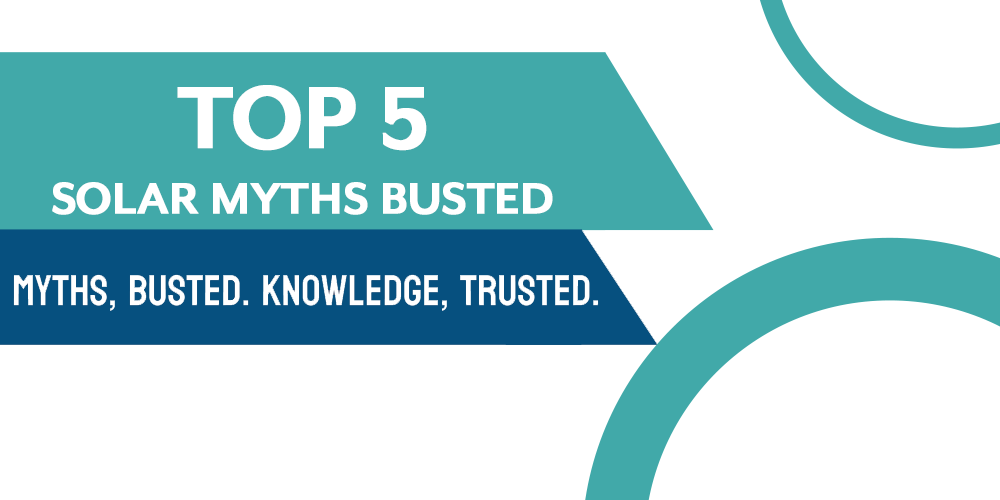Top 5 Solar Myths Busted: Debunking Myths & Barriers to Going Solar

As solar energy continues to gain popularity as a clean and sustainable power source, it's crucial to separate fact from fiction. Unfortunately, several persistent myths and misconceptions about solar energy have led to confusion and misinformation. Our team set out to get answers to the top solar myths and debunk them once and for all.
Myth 1 : Solar panels are too expensive and not cost-effective.
One common misconception is that solar panels are prohibitively expensive, making them impractical for the average homeowner. While many homeowners may not be able to afford the up to $20K+ upfront costs of installing solar panels, companies like PosiGen are working to make solar energy savings affordable to everyone with its unique leasing program.
The lease is designed to allow homeowners to reap the energy saving benefits of solar with no upfront costs and no credit and income requirements (which are typically required in the industry). With this approach, PosiGen approves homeowners based on homeownership + utility usage history, NOT on credit score or income, enabling a population historically ignored by the solar community, and underserved or poorly served by most energy efficiency programs, to access the benefits of clean energy. PosiGen’s core offering is a 25-year solar lease that includes an energy efficiency upgrade for 100% of solar feasible homeowners who may not otherwise be able to afford solar or energy efficiency upgrades.
Myth 2: Solar panels are not efficient enough to generate adequate power.
Some believe that solar panels are inefficient and incapable of producing sufficient electricity. However, advancements in solar technology have dramatically improved the efficiency of solar panels. Modern solar panels can convert sunlight into electricity with high efficiency rates, and even in less than ideal conditions, they can still generate a substantial amount of power. In fact, according to the U.S. Department of Energy, the sunlight reaching the earth’s surface in an hour and a half timeframe could handle the entire world’s energy needs for a year!
So yes, solar panels can power an entire home depending on the size of the solar panel system and the energy needs of the home. A properly sized and designed solar panel system can generate enough electricity to meet the energy demands of a household, allowing for self-sufficiency and potentially even net-zero energy consumption.
To determine if solar panels can power an entire home, several factors need to be considered:
- Energy Consumption: The first step is to assess the energy consumption of the home. This involves understanding the average monthly electricity usage, peak demand, and seasonal variations. This information helps determine the size of the solar panel system required to meet the household's energy needs.
- Solar Potential: The location and solar potential of the property play a crucial role. Homes in areas with ample sunlight throughout the year have higher solar potential and can generate more electricity from solar panels. Factors like shading, roof orientation, and tilt angle need to be considered to maximize solar energy production.
- System Sizing: Solar panel systems are typically sized based on the average energy consumption of the home. A professional solar installer can assess the energy needs and design a system that meets the household's requirements. This involves considering factors like panel efficiency, available roof space, and local regulations.
By taking these factors into account, it is indeed possible for solar panels to power an entire home. Solar energy systems can provide a significant portion of a home's electricity needs, and with efficient energy management.
Myth 3: Solar energy is only suitable for warmer climates.
Contrary to popular belief, solar energy can be harnessed effectively in various climates, including regions with less sunshine. Solar panels can generate electricity even on cloudy or overcast days. While solar panels do perform optimally under direct sunlight, they still produce power under diffused sunlight. Additionally, solar energy systems can be designed to meet the specific needs of different locations, ensuring efficient energy production regardless of the climate.
According to the Department of Energy’s Energy Sage article, cold weather can improve performance of solar panels. The reflection from snow is also beneficial to the solar panels. While the production of the panels may be reduced when blocked by snow and ice, a professional installer takes into account your roof’s pitch to help snow slide off the panels
Myth 4: Solar panels require constant maintenance and are fragile.
Some people worry that solar panels are delicate and prone to damage, requiring extensive and costly maintenance. In reality, solar panels are designed to withstand various weather conditions and are built to last for decades. They have no moving parts, which minimizes the risk of mechanical failure. Routine maintenance, such as cleaning debris and ensuring proper wiring, is usually sufficient to keep solar panels operating optimally.
Myth 5: Solar energy is not reliable and cannot provide consistent power.
A common misconception is that solar energy is intermittent and unreliable, as it relies on sunlight. However, solar power systems can be interconnected with the electrical grid or incorporate energy storage solutions to provide consistent power supply even during cloudy periods or at night.
When it comes to longevity, panels are built to go the distance. In a recent blog, PosiGen talked about how panels can last up to 30 years with relatively little maintenance.
Dispelling myths and misconceptions surrounding solar energy is crucial for informed decision-making and wider adoption of this sustainable power source. PosiGen has revealed the truth about solar energy's affordability, efficiency, adaptability, durability, and reliability. Embracing solar energy can contribute to a greener and more sustainable future while enjoying the numerous benefits it offers for homeowners and the environment alike.
